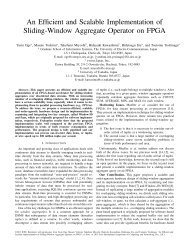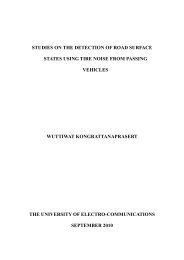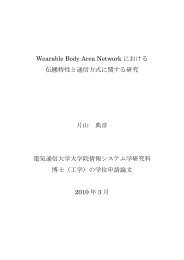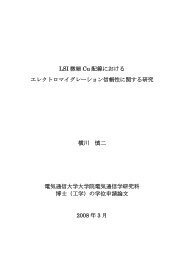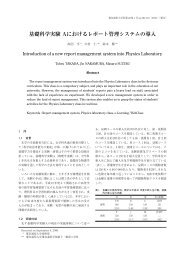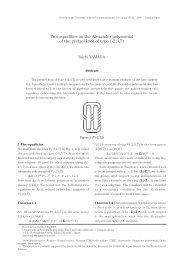Approximation of Hessian Matrix for Second-order SPSA Algorithm ...
Approximation of Hessian Matrix for Second-order SPSA Algorithm ...
Approximation of Hessian Matrix for Second-order SPSA Algorithm ...
Create successful ePaper yourself
Turn your PDF publications into a flip-book with our unique Google optimized e-Paper software.
2.3 PROPOSED MAPPING<br />
λ and 0<br />
where > 0<br />
q<br />
λ<br />
q + 1<br />
≤ . As k<br />
H is a real-valued, its eigenvalues are real-valued,<br />
too. The eigenvalues <strong>of</strong><br />
H are computed as follows:<br />
k<br />
The number <strong>of</strong> non-zero eigenvalues is equal to the rank <strong>of</strong> H<br />
k<br />
, i.e., at most three non-zero<br />
eigenvalues are available. In this part, the following arrangement <strong>of</strong> eigenvalues is assumed:<br />
λ<br />
≥<br />
≥<br />
1<br />
λ<br />
2<br />
λ<br />
3<br />
. The technique presented here, requires much less user interaction. Now, the<br />
theoretical background is explained leading to a two-fold threshold algorithm where the only<br />
task <strong>of</strong> the user is to specify two thresholds. Finding the eigenvalues and eigenvectors <strong>of</strong> the<br />
<strong>Hessian</strong> matrix is closely related to its decomposition<br />
H<br />
i<br />
= PD P<br />
−1<br />
(2.6)<br />
where P is a matrix and its columns are H’s eigenvectors and<br />
D<br />
i<br />
is a diagonal matrix having<br />
H’s eigenvalues on the <strong>Hessian</strong>. While computing the gradient magnitude by the Euclidean<br />
norm requires three multiplications, two additions and one square root, the computation <strong>of</strong><br />
eigenvalues <strong>of</strong> the <strong>Hessian</strong> matrix is more suitable. The explicit <strong>for</strong>mula would require solving<br />
cubic polynomials. In our implementation a numerical technique <strong>of</strong> fast converging called<br />
Jacobi’s method is used as is recommended in [20] <strong>for</strong> symmetric matrices. We have proposed<br />
an easy-to-use framework <strong>for</strong> exploiting eigenvalues <strong>of</strong> the <strong>Hessian</strong> matrix to represent volume<br />
data by small subsets.<br />
The relation <strong>of</strong> eigenvalues to the Laplacian operator is recalled, this shows the suitability <strong>of</strong><br />
threshold eigenvalue volumes, and define a two-fold threshold operation to generate sparse data<br />
sets. For data where it can be assumed that objects exhibit higher intensities than background,<br />
we modify the framework taking into account only the smallest eigenvalue. This results in a<br />
further reduction <strong>of</strong> the representative subsets by selecting just data at the interior side <strong>of</strong> object<br />
boundaries. For the sake <strong>of</strong> simplicity, we have omitted the index k <strong>for</strong> the individual eigenvalue<br />
λ<br />
i that is a function <strong>of</strong> k. Next, we assume that the negative eigenvalues will not lead to a<br />
physically meaningful solution. They are either caused by errors in<br />
H<br />
k<br />
or are due to the fact<br />
that the iteration has not reached the neighborhood <strong>of</strong><br />
θ<br />
*<br />
where the loss function is locally<br />
quadratic. There<strong>for</strong>e, we replace them together with the smallest positive eigenvalue with a<br />
descending series <strong>of</strong> positive eigenvalues:<br />
23



